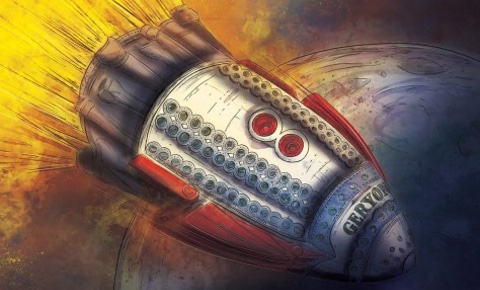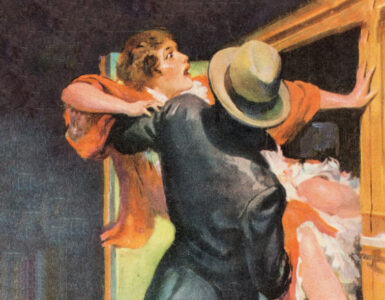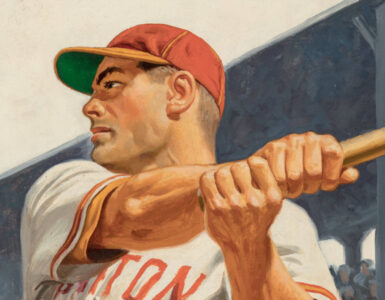Pulp magazines have influenced writers, artists, film directors, software developers, and countless others over the years. Our “PulpFest Profiles” focus on contemporary creators who have drawn inspiration from these rough-paper fiction magazines.

At PulpFest 2019, I discovered an extraordinary project called, First Fandom Experience. Father and son, David and Daniel Ritter, are dedicated pulp fans and collectors with a special interest in the early days of science fiction fandom. They have created a database of materials made available through their website and in several books. Their most recent release is THE EARLIEST BRADBURY, which came out in 2020 to coincide with the hundredth anniversary of Ray Bradbury’s birth. Recently, I had the chance to sit down with David and Daniel and ask them some questions about their exciting First Fandom Experience project.
Sara Light-Waller (SLW): David, you’re Editor-in-Chief of First Fandom Experience and a long-time pulp fan. Please tell us about your initial inspiration for the First Fandom Experience (FFE) project.
David Ritter: FFE is my second adventure in publishing related to science fiction in the 1930s. The first was The Cosmos Project. You can read about it and my background with it, here. The way COSMOS came together in the early 1930s is a microcosm of the overall phenomenon of organized fandom during that decade. Once The Cosmos Project was largely complete, I continued to explore the broader arc of fan history. This led me to what’s considered the canonical narrative of early fandom: Sam Moskowitz’s THE IMMORTAL STORM. Moskowitz captured the stories of many of the key people and events of the early years from his own first-hand experience and with his distinctive perspective.
While it was all well and good to read about the clubs, publications, and gatherings that bootstrapped the science fiction industry, it was also unsatisfying, I wanted to dig into the dirt myself. So I started to seek out more of the original material created by folks who have come to be known as the “First Fans.”
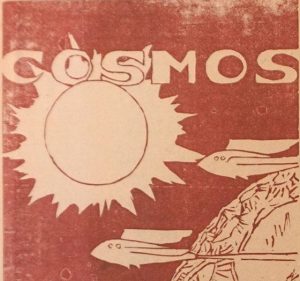
I’d been toying with the idea of creating a facsimile edition of COSMOS, patterned after the chapter inserts from its original publication. At the Windy City Pulp and Paper Convention in 2017, I kicked this idea around with Doug Ellis, one of the founders and organizers of the show. Doug is a prominent collector and publisher of several volumes of science fiction and pulp art. I also spoke with John L. Coker III, President and Archivist of the First Fandom organization. John has done more to preserve and honor the memories of the First Fans than anyone else through his various writing and publishing projects. He had been a contributor to The Cosmos Project, educating me and providing great material highlighting the key role of Conrad H. Ruppert and his printing press. It was John who suggested that perhaps more of the original fanzines from the early days could be brought out as facsimiles. This was the inception of First Fandom Experience.
Initially, I imagined that full facsimile runs of the key fan publications from the 1930s might be produced. Doug however, convinced me that this was impractical, if not entirely insane. Over the next few months and through many discussions, the alternate concept of a “visual history” of the period gradually formed.
At about this same time, I began to understand that anything approaching a robust visual treatment of early fandom would be a pretty massive job and that trying to do it as a part-time hobby would take many years. I suggested to my middle son, Daniel, that he quit his job and join the project full-time. When we look back in the future, I hope he thanks me for this. Time will tell.
SLW: Daniel, you’re Managing Editor of FFE, what are your thoughts about bringing old-school pulp to younger readers?
Daniel Ritter: It’s a challenge, but one I’m optimistic and enthusiastic about. Most science fiction readers my age (Millennials) are aware of the old-school “pulpiverse.” However, very few have any real familiarity with the literary content of old pulps, the history of pulps, or the history of fandom. They are familiar with big-name authors like Bradbury, Asimov, and Heinlein but younger readers have no real understanding of their works’ historical context. I have had much success engaging people my age by using these big-name authors as anchor points for unpacking the history and impact of early fandom. Certain themes also seem engaging to younger readers, such as how robots or rocket ships were imagined in the early days of science fiction. Social themes, like the relationship between science and society or how a space-bound culture ought to be structured, are particularly compelling because they are still incredibly relevant today.
Overall, I’ve found the best way to engage younger readers is to share our passion for the history of science fiction and fandom. Passion is infectious and a powerful way to introduce fandom’s history to younger readers. Especially when the stories relate to ideas and issues still relevant today.
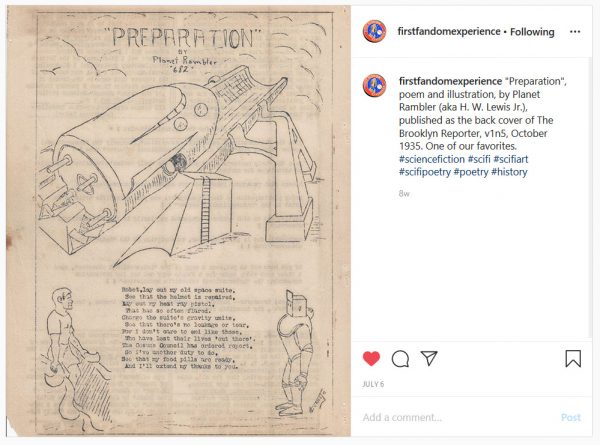
SLW: Please tell us more about your FFE team.
First Fandom Experience (FFE): We describe First Fandom Experience as a collaborative publishing project. It really does take a village to bring together all the material and historical context necessary for our work. We are fortunate to have a core team of collectors and historians as collaborators, as well as a wide network of contributors who have provided important information and materials. We have deep gratitude for all of our collaborators.
Outside of David and Daniel, our core team consists of:
- John L. Coker III, a long-time fan, collector, historian, and President of First Fandom, whose insight and knowledge has been essential to our work
- Sam McDonald, a collector and researcher whose ability to locate obscure material is unparalleled
- Doug Ellis, a collector extraordinaire who has helped fill many gaps in our archive.
- Kate Baxter, a younger fan who has helped us secure many key artifacts from the dusty basements of library collections
There are many other people who have contributed to our work in many ways — too many to list here. In no particular order again:
- Jim Emerson, publisher of “FUTURES PAST”
- Alistair Durie, a leading fan and collector in the United Kingdom
- Robert A. Madle, a prominent “First Fan” who just celebrated his 100th birthday
- Jonathan Eller, Director of the Center for Ray Bradbury Studies
- Michael Saler, Professor of History at UC Davis
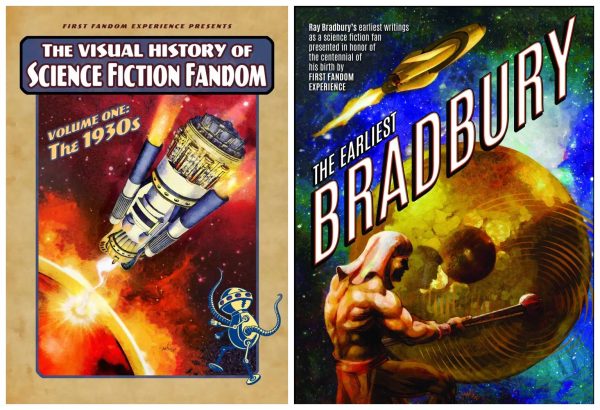
SLW: You’ve published several books in the last few years, please tell us about them.
FFE: Our first major publication was THE VISUAL HISTORY OF SCIENCE FICTION FANDOM, VOLUME ONE: THE 1930s. At over 500 pages, this was an ambitious effort to robustly cover the emergence and early development of science fiction fandom. It’s presented chronologically, touching on some pre-1930s activity but really taking foot in 1930. It is capped off with the 1939 Worldcon. This volume showcases our overall goals: telling the story of fandom through artifacts and materials produced by fans during this decade. It also includes several original, documentary-style comic sections, which bring to life key stories from the history.
THE EARLIEST BRADBURY is our second major publication. This volume is an exploration and celebration of Ray Bradbury’s earliest writings as a science fiction fan. It was produced in the same spirit as THE VISUAL HISTORY. We focus on the actual historical artifacts produced by Bradbury and his peers and present them in full facsimile form.
We’ve also published a full facsimile reproduction of the seminal fanzine SCIENCE FICTION DIGEST — later named FANTASY MAGAZINE — along with the serial novel COSMOS, that was originally published in its pages.
In the future, we hope to publish a collection of early fan art, and we have been discussing volume two of THE VISUAL HISTORY, which would cover the early 1940s.
SLW: In THE VISUAL HISTORY OF SCIENCE FICTION FANDOM you credit pulp collector, Robert A. Madle, as being a seminal part of FFE. Can you tell us more about that?
FFE: Among many other places, our quest for a comprehensive view of early fan history led us to the basement of Robert A. Madle in Rockville, Maryland. Bob was a prominent fan in the Philadelphia area beginning in the early 1930s and has since become a legendary collector and dealer in the field. I’m honored that he entrusted us to give a good home to his original copies of THE PLANET and THE TIME TRAVELER, seminal early fan publications without which any coverage of this era would be sorely incomplete. We’ve compiled a tribute to Bob’s seminal role in fandom on our website.

SLW: Your books and website are virtual cornucopias of rare information from the early days of science fiction fandom. Who are your favorite figures from those early days?
FFE: We often joke that if you were a young science fiction fan in the 1930s, you were a “Moskowitz person” or a “Wollheim person.” We both think we would be Wollheim people. His passion, idealism, and his bold vision of the role that science fiction fans could play in the world speaks to us even now. Wollheim was also surrounded by a crowd of interesting people like John B. Michel and Frederik Pohl, whose antics could spawn a sitcom. If we were teenagers in the late 1930s, I suspect we would have found ourselves attending meetings of the Futurians.
Cyril M. Kornbluth was a figure who is incredibly interesting to us. He is remembered by many of his peers as someone who always spoke his mind. Accounts from people like Damon Knight and Isaac Asimov describe stories like how he decided to read the entire encyclopedia, in order from A to Z. One account from Pohl suggests he never brushed his teeth. Others describe that when they first met, Kornbluth would punch them in the stomach — apparently as a way to make the meeting memorable.
The young Bradbury is another character who is almost larger than life. Charming, witty, and funny, his endearing voice on the page seems an honest reflection of his personality.
SLW: What would you like readers to get out of FFE books and your website?
FFE: We want to give people a visceral sense of what it was like to be one of the first fans of science fiction. The 1930s and early 1940s were an incredible period. Science fiction as a genre was born during that time. Fans, writers, artists, and editors defined and developed the science fiction genre over the following decades. Their impact is seen today in the community and genre we know and love.
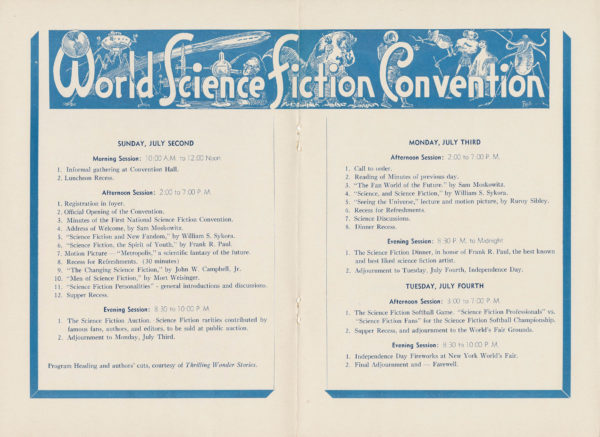
We want to share this history, bringing it to life so readers can understand and appreciate the origins and impact of the early fans. We hope to add depth and flavor to readers’ appreciation of both modern science fiction literature and community.
SLW: Who do you think is your largest audience — collectors, readers, others?
FFE: Collectors — and it’s probably fair to call most collectors historians — seem to be our largest audience. Our work is primarily historical and contains lots of facsimile reproductions of rare or obscure material. So it speaks loudest to those who already treasure this kind of material.
SLW: Ultimately, what’s your goal for FFE?
FFE: We hope to preserve the history and impact of early fandom. We believe this history is both interesting and important. The story of fandom speaks to the importance of imagination as a survival skill and a catalyst for change. What we can imagine, we can create — both good and bad. The infectious energy of fans who embrace and promote the possible gives us hope for the future. We want to ensure that their story remains a treasured part of the collective consciousness of the science fiction community.
SLW: Is there anything else you’d like to mention today?
FFE: We really appreciate the conversation! The annual PulpFest is a key part of the origin story for First Fandom Experience, and we look forward to our next chance to get together with our fellow fans.
Many thanks to David and Daniel Ritter for this great conversation. If you’d like to find out more about the First Fandom Experience project please stop by their website, follow them on Twitter (@FirstFandomExp), Instagram (firstfandomexperience) or subscribe to their blog. Their books can be purchased through their website or digitally through Amazon.
You can also read more about First Fandom Experience on Sara Light-Waller’s blog at Lucina Press. That’s where you’ll find part two of her interview with David and Daniel Ritter — Super-Science Kids: First Fandom Experience, Part 2.
Just click on the link above and you’re there! How’s that for Super-Science?
(A professional journalist and illustrator with over thirty years of experience, Sara Light-Waller is an accomplished new-pulp fiction author/illustrator with two books out and more on the way. She is also the winner of the 2020 Cosmos Prize for her illustrated short story, “Battle at Neptune.” A huge pulp fan, Sara is especially fond of science fiction pulps. The extent of her pulp fandom can best be measured by the oversized rendition of Frank R. Paul’s AMAZING STORIES cover that she painted on her garage. Sara is a member of the PulpFest organizing committee, a regular contributor to our homepage and THE PULPSTER, and often reads for PulpFest‘s “New Fictioneers.”)

